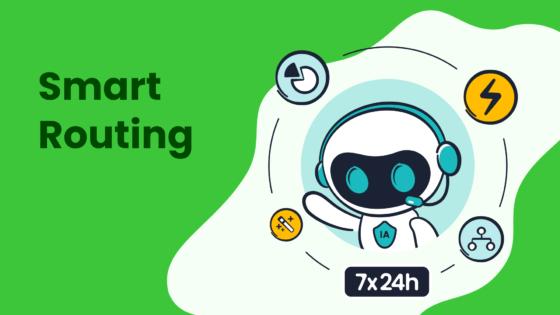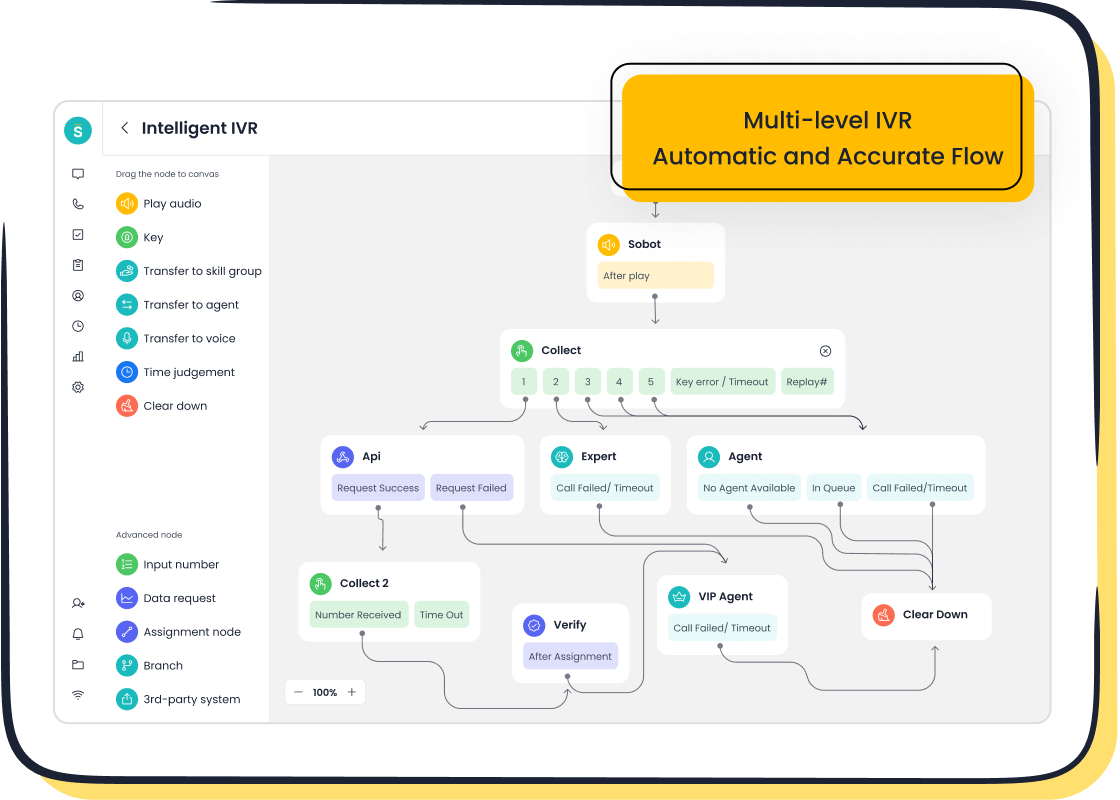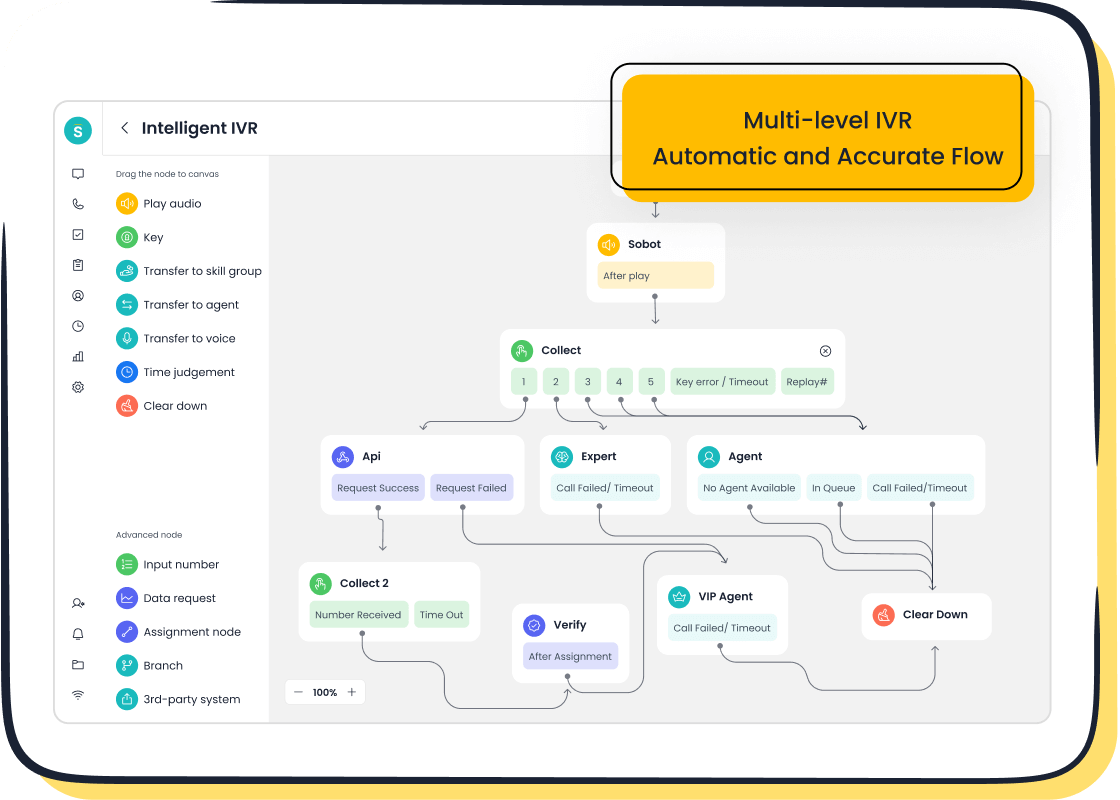How to Optimize CRM Contact Center Integration for Success

In today’s fast-paced business world, integrating your CRM with a contact center plays a pivotal role in driving success. This integration empowers you to deliver exceptional customer service, streamline operations, and achieve measurable business outcomes. For instance, 94% of companies report increased sales productivity after adopting CRM solutions, while 47% see significant improvements in customer retention. Additionally, seamless CRM contact center integration can help resolve 60% of First Contact Resolution failures caused by inaccessible data. With tools like Sobot’s innovative solutions, you can create unified customer experiences that foster loyalty and satisfaction.
So, is your business ready to unlock the full potential of CRM contact center integration?
Understanding CRM and Contact Center Integration
What is CRM Contact Center Integration?
CRM contact center integration refers to the seamless connection between your customer relationship management (CRM) system and your contact center. This integration allows you to unify customer data, interaction history, and communication channels into one platform. By doing so, you can provide personalized support, streamline workflows, and enhance overall efficiency.
The integration involves several key components and systems that work together to optimize operations. Here’s a quick overview:
| Component/System | Description |
|---|---|
| Customer relationship management (CRM) | Consolidates customer data and interaction history for personalized support. |
| Artificial intelligence and automation | Enhances efficiency with chatbots and predictive analytics for proactive assistance. |
| Interactive voice response (IVR) | Routes customers to appropriate departments, reducing wait times. |
| Performance analytics and reporting | Provides real-time dashboards for tracking performance and customer satisfaction. |
| Call recordings | Essential for quality management and training, offering insights into customer behavior. |
Why is Integration Essential for Customer Service Excellence?
Integration is vital for delivering exceptional customer service. It ensures that your agents have access to real-time customer data, enabling them to resolve issues faster and more effectively. Features like intelligent call routing and click-to-call streamline operations, reducing response times and improving customer satisfaction.
Additionally, integrated systems allow you to leverage advanced tools like speech analytics and predictive dialers. These tools provide deeper insights into customer needs and behavior, helping you anticipate issues and offer proactive solutions. This level of service builds trust and loyalty, setting your business apart from competitors.
Key Benefits of Integration for Businesses
CRM contact center integration offers numerous advantages that directly impact your business outcomes. For instance:
- Businesses report a 21-30% increase in sales revenue after implementing CRM systems.
- Companies using integrated solutions save 5-10 hours per week, boosting productivity.
- Customer retention rates improve by 93%, while acquisition costs decrease by 91%.
These benefits highlight how integration not only enhances customer service but also drives operational efficiency and profitability. By adopting effective strategies, you can unlock the full potential of CRM integration and achieve long-term success.
Strategies to Optimize CRM and Contact Center Integration
Real-Time Data Synchronization for Seamless Operations
Real-time data synchronization ensures that your contact center and CRM systems always have the most up-to-date information. This synchronization eliminates delays in accessing customer data, enabling your agents to provide outstanding service. For example, when a customer updates their contact details or submits a query, the system reflects these changes instantly. This reduces errors and ensures smooth communication between teams.
Real-time data updates also enhance collaboration. Agents can access accurate customer histories, allowing them to resolve issues faster. According to industry insights, synchronized data reduces misinformation and improves operational efficiency. This approach not only saves time but also boosts customer satisfaction by ensuring consistent and personalized service.

Sobot’s solutions, such as the Cloud Call Center, excel in real-time data synchronization. With features like intelligent IVR and unified workspaces, your team can access customer information instantly. This ensures seamless operations and enhances the overall customer experience.
Automating Repetitive Tasks to Boost Efficiency
Automation is a game-changer for contact center optimization. By automating repetitive tasks, you free up your agents to focus on more complex customer interactions. Tasks like call routing, ticket creation, and follow-up reminders can be handled by AI-driven systems, improving efficiency and reducing errors.
Research shows that companies using AI-driven automation experience a 15-20% increase in customer satisfaction while cutting costs. For instance, AI virtual agents reduced call volumes by 25% for Purchasing Power, delivering a positive ROI within three months. Automating workflows also improves first-contact resolution rates, which can exceed 95% with full AI integration.

Sobot’s AI-powered Voicebot is an excellent example of automation in action. It handles routine inquiries, recognizes customer intent, and provides instant responses. This not only enhances customer service but also optimizes your workforce by reducing manual workloads.
Implementing Omnichannel Communication for Better Customer Interactions
Omnichannel communication is essential for delivering exceptional customer service. It allows customers to interact with your business through their preferred channels, whether it’s email, social media, or voice calls. A unified platform ensures that all interactions are tracked and managed seamlessly, creating a consistent customer experience.
Data highlights the effectiveness of omnichannel strategies. For example, 85% of customers prefer engaging with businesses across multiple channels, and companies using three or more channels see a 287% improvement in engagement rates. This approach not only enhances customer retention but also drives sales productivity.
Sobot’s Omnichannel Solution simplifies this process by integrating all communication channels into one platform. With features like AI-driven chatbots and unified workspaces, your team can deliver personalized service across every touchpoint. This ensures that your customers receive the same level of care, regardless of how they choose to connect with you.
Personalizing Customer Experiences with Unified Data
Personalizing customer experiences is no longer optional; it’s a necessity in today’s competitive market. By unifying data from your CRM and contact center, you can create tailored interactions that resonate with your customers. This approach ensures that every touchpoint feels relevant and meaningful, fostering trust and loyalty.
Unified data allows you to understand your customers better. For example, when you integrate CRM data with contact center systems, you gain a 360-degree view of customer preferences, purchase history, and interaction patterns. This insight enables you to offer personalized recommendations, targeted promotions, and proactive support. Companies like Netflix and Starbucks have successfully leveraged unified data to enhance customer experiences. Netflix’s recommendation engine, powered by integrated user data, drives 80% of its streamed content. Similarly, Starbucks uses data from its loyalty programs and mobile app to make data-driven decisions, contributing to sustained growth and profitability.
| Company | Impact Description | Result |
|---|---|---|
| Coca-Cola | Utilized unified data platforms to create targeted marketing campaigns. | 4% increase in global sales. |
| Netflix | Recommendation engine powered by integrated user data. | 80% of content streamed. |
| Starbucks | Integrated data from loyalty programs and mobile app for data-driven decisions. | Sustained growth and profitability. |
| N/A | Personalized recommendations boosted average order value. | Increased sales by 30%. |
| N/A | Tailored loyalty programs increased repeat purchases. | Improved customer retention by 25%. |
Sobot’s Omnichannel Solution exemplifies how unified data can transform customer interactions. By consolidating communication channels and customer information into a single platform, it empowers your team to deliver exceptional customer service. Features like AI-driven chatbots and unified workspaces ensure that every interaction is personalized and efficient. This level of optimization not only enhances customer satisfaction but also drives customer retention and repeat business.
Monitoring and Analyzing Performance Metrics Post-Integration
Once you’ve integrated your CRM and contact center, monitoring and analyzing performance metrics becomes crucial. These metrics help you measure the success of your integration and identify areas for improvement. Key performance indicators (KPIs) such as average handle time, first contact resolution, and customer satisfaction scores provide valuable insights into your operations.
| Importance of Operational Metrics and KPIs | Description |
|---|---|
| Align operational processes with business strategy | Ensures that operations support overall strategy by measuring metrics tied to objectives. |
| Increase accountability and ownership | Provides clear performance measures, helping employees understand expectations. |
| Communicate progress to stakeholders | Demonstrates commitment to improvement and keeps management informed. |
| Identify underperforming areas | Offers real-time visibility to adapt quickly to challenges and opportunities. |

Analyzing these metrics allows you to optimize workflows and improve efficiency. For instance, tracking first contact resolution rates can reveal whether your agents have the tools and information they need to resolve issues quickly. Real-time dashboards, like those offered by Sobot’s Cloud Call Center, provide actionable insights that help you make informed decisions. These tools also encourage proactive identification of inefficiencies, ensuring that your contact center remains agile and competitive.
By aligning operational improvements with your overall CRM strategy, you can achieve outstanding service and long-term success. Regularly reviewing performance metrics ensures that your team stays on track and continues to deliver value to your customers. This approach not only supports efficient workforce management but also fosters continuous training and development, keeping your team prepared for future challenges.
The Role of Technology in Enhancing CRM Contact Center Integration

Selecting the Right Tools for Integration
Choosing the right tools is the foundation of successful CRM contact center integration. The tools you select should align with your business goals and enhance your crm strategy. They must also simplify workflows, improve customer retention, and support contact center optimization. To make an informed decision, consider the following criteria:
| Criteria Type | Description |
|---|---|
| Content Accuracy | Ensures the information provided by the tool is correct and reliable. |
| Intuitiveness | The ease with which users can navigate and use the tool. |
| Interactivity | The level of engagement the tool provides to users. |
| Quality | Overall standard of the tool in terms of design and functionality. |
| Integration Strategy | Approaches to effectively incorporate the tool into your crm strategy. |
| Model Literacy Skills | Demonstrating a literacy skill or strategy through the tool. |
| Guide Literacy Skills | Assisting users in developing a literacy skill or strategy with the tool. |
| Model Digital Features | Showing how to use specific features of the tool effectively. |
| Guide Digital Features | Helping users understand how to utilize the tool's features. |
When evaluating tools, prioritize those that offer advanced technology like AI-driven automation and real-time data synchronization. These features streamline operations and improve customer experience. For example, Sobot’s Cloud Call Center provides intelligent IVR and unified workspaces, ensuring seamless integration and efficient workforce management.
API Compatibility and Customization for Flexibility
APIs play a critical role in CRM contact center integration. They enable different systems to communicate and share data, creating a unified platform. Flexible APIs allow you to customize integrations based on your unique business needs, enhancing your crm strategy and supporting contact center optimization.
| Aspect | Description |
|---|---|
| Compatibility with Existing Systems | Assess whether the CRM API can easily integrate with your current software stack, including databases, applications, and other third-party services. It’s important to check if the API supports the programming languages and frameworks used by your organization, facilitating smoother integration efforts. |
Integrated systems provide a single source of truth, ensuring every department operates from the same data. This harmonized data ecosystem eliminates discrepancies and reduces duplication efforts. It also fosters greater collaboration across teams, improving overall efficiency.
Headless CRMs offer even greater flexibility. They are not limited by pre-built interfaces, allowing you to use APIs to integrate customer data with any front-end application, website, or mobile app. This approach enables you to create tailored user experiences that meet specific customer segments or business needs. By leveraging API customization, you can optimize workflows and enhance customer retention.
Cloud-Based vs. On-Premises Systems: Which is Better?

The choice between cloud-based and on-premises systems depends on your business requirements. Cloud-based systems offer scalability, cost-effectiveness, and easy access from anywhere. They are ideal for businesses looking to adopt advanced technology without significant upfront investment. For example, Sobot’s Cloud Call Center operates on a SaaS model, providing global telephony support and a 99.99% uptime guarantee.
On-premises systems, on the other hand, provide greater control over data and infrastructure. They are suitable for businesses with strict compliance requirements or those operating in industries where data security is a top priority. However, they require higher initial investments and ongoing maintenance.
| Feature | Cloud-Based Systems | On-Premises Systems |
|---|---|---|
| Scalability | Easily scalable to meet growing demands. | Limited by hardware and infrastructure. |
| Cost | Lower upfront costs; subscription-based. | Higher initial costs; ongoing maintenance. |
| Accessibility | Accessible from anywhere with an internet connection. | Restricted to on-site access. |
| Security | Relies on vendor’s security measures. | Full control over data and security. |
| Maintenance | Managed by the service provider. | Requires in-house IT support. |
For most businesses, cloud-based systems provide the flexibility and scalability needed for efficient workforce management and contact center optimization. They also support rapid deployment and integration, making them a preferred choice for modern CRM strategies.
Leveraging AI and Machine Learning for Smarter Integration
Artificial intelligence (AI) and machine learning (ML) have revolutionized how businesses approach CRM integration. These technologies empower you to streamline operations, enhance decision-making, and improve customer interactions. By leveraging AI and ML, you can transform your CRM strategy into a smarter, more efficient system.
AI simplifies repetitive tasks, such as data entry and follow-ups, reducing errors and saving time. For example, AI systems automatically update customer information, ensuring your contact center operates with accurate data. Machine learning algorithms also analyze customer behavior, helping you predict trends and make informed decisions. This predictive capability enables you to anticipate customer needs and deliver proactive solutions.
| Contribution Type | Description |
|---|---|
| Automated Data Entry | AI systems reduce manual entry errors and save time by automatically entering and updating customer information. |
| Smart Scheduling | AI optimizes meeting schedules based on availability and customer preferences. |
| Lead Scoring | Machine learning algorithms score leads based on conversion likelihood, helping prioritize sales efforts. |
| Process Automation | AI streamlines business processes, reducing time and effort for tasks like order processing. |
| Predictive Analytics | AI analyzes historical data to predict customer behavior and market trends, aiding strategic decisions. |
| Real-time Insights | AI provides up-to-the-minute insights for quick responses to customer needs. |
| Optimization Recommendations | AI suggests ways to optimize marketing campaigns and sales strategies. |
| AI Chatbots | Virtual assistants handle customer queries, providing instant support and freeing up human agents. |
| Automated Follow-up | AI sends personalized follow-up emails based on customer interactions. |
| Report Generation | AI generates detailed reports and analytics without manual data compilation. |
The adoption of AI and ML is growing rapidly across industries. The market for these technologies is projected to expand from $4.1 billion in 2023 to $48.4 billion by 2033. This growth reflects their ability to enhance customer experience and operational efficiency. For instance, AI-driven chatbots can handle customer inquiries instantly, freeing up your workforce to focus on complex issues. This not only improves customer retention but also boosts productivity.
Sobot’s AI-powered Voicebot exemplifies how AI can elevate your CRM strategy. It recognizes customer intent, provides instant responses, and automates routine tasks. By integrating AI into your contact center, you can deliver faster, more personalized service while optimizing your workforce.
How Sobot's Voice/Call Center Enhances Integration
Sobot’s Voice/Call Center offers a comprehensive solution for seamless CRM integration. Its advanced features ensure that your contact center operates efficiently, enhancing both customer satisfaction and operational performance.
One standout feature is the intelligent IVR system. This tool routes calls to the right agents or departments, reducing wait times and improving first-contact resolution rates. Additionally, the unified workspace consolidates customer data, enabling your team to access all relevant information in one place. This streamlined approach minimizes errors and ensures consistent service.
Sobot’s Voice/Call Center also excels in real-time monitoring and analytics. These tools provide actionable insights into performance metrics, helping you identify areas for improvement. For example, tracking average handle time and customer satisfaction scores allows you to refine your processes and enhance service quality.
| Case Study | Metrics/Results | Benefits Demonstrated |
|---|---|---|
| Delta Airlines | Reduced wait times significantly through the 'Ask Delta' chatbot. | Enhanced efficiency in customer interactions. |
| Maruti Suzuki | Engaged over 400,000 users, handled millions of queries, facilitated thousands of bookings. | Improved customer satisfaction and engagement. |
Sobot’s platform also supports global telephony, ensuring reliable communication across different regions. With a 99.99% uptime guarantee, you can trust the system to deliver consistent performance. The integration capabilities of Sobot’s Voice/Call Center make it an invaluable tool for optimizing your CRM strategy. By adopting this solution, you can improve customer retention, streamline operations, and achieve long-term success.
Best Practices for Workforce Training and Process Alignment
Training Teams on CRM and Contact Center Tools
Training your workforce on CRM and contact center tools is essential for maximizing their potential. When your team understands how to use these tools effectively, they can deliver better customer service and improve operational efficiency. Focus on hands-on training sessions that familiarize agents with features like real-time data synchronization, intelligent IVR, and unified workspaces.
Training outcomes often reflect in key performance metrics. For example:
| Metric | Description |
|---|---|
| Customer Satisfaction Scores | Measures how satisfied customers are with the service provided. |
| First Call Resolution Rates | Indicates the percentage of calls resolved on the first interaction without the need for follow-up. |
| Agent Utilization Rates | Reflects how effectively agents are being utilized during their working hours. |
These metrics highlight the importance of continuous training and development. Improved customer satisfaction scores, increased first call resolution rates, and enhanced agent utilization rates are direct results of well-trained teams. By investing in training, you empower your workforce to handle customer interactions with confidence and efficiency.
Aligning Processes Across Departments for Consistency
Process alignment across departments ensures that your strategies remain consistent and effective. When teams work in harmony, they can prioritize goals, reduce wasted resources, and foster transparency. For example, creating an effective prioritization process helps your organization focus on important objectives while avoiding inefficiencies.
Aligned companies often experience measurable benefits:
- Aligned companies lost 36% fewer customers than non-aligned companies according to a global Benchmark Report.
- Companies with aligned sales and marketing have a 30% higher rate of return.
Additionally, fostering transparency builds trust between teams and reduces misunderstandings. Utilizing a matrix organization structure encourages collaboration, breaking down silos and promoting strategic teamwork. These practices ensure that your workforce operates cohesively, delivering consistent customer service across all touchpoints.
Encouraging Collaboration Between IT and Customer Service Teams
Collaboration between IT and customer service teams is crucial for successful CRM integration. When these teams work together, they can streamline workflows, unify customer data, and align their goals. For example, Siemens integrated CRM with marketing automation tools to improve targeted campaigns, while HubSpot unified customer data into a single platform accessible to all teams.
| Company | Collaboration Strategy | Outcome |
|---|---|---|
| Siemens | Integrated CRM with marketing automation tools for seamless lead handoff. | Improved targeted marketing campaigns through data analytics on customer behavior. |
| HubSpot | Unified customer data in a single CRM platform accessible to all teams. | Established shared KPIs and dashboards, aligning all departments with business goals. |
Encouraging collaboration ensures that IT provides the technical support needed for customer service teams to succeed. Shared KPIs and dashboards align departments with business objectives, fostering a unified approach to customer interactions. This teamwork enhances efficiency and drives better outcomes for your CRM strategies.
Regularly Updating and Refining Integration Processes
Regular updates and refinements to your integration processes are essential for maintaining efficiency and ensuring long-term success. As your business evolves, your CRM and contact center systems must adapt to meet new demands. Regularly reviewing and improving these processes helps you stay ahead of potential issues and optimize performance.
Start by implementing comprehensive monitoring of data integration metrics. Track key performance indicators (KPIs) such as data processing time, error rates, and data completeness. Real-time monitoring tools can help you identify bottlenecks and address issues as they arise. This proactive approach ensures your systems remain reliable and efficient.
Here’s a breakdown of critical metrics to monitor:
| Metric Name | Unit | Remarks |
|---|---|---|
| Integrated Changes | changes | Total number of inserts, updates, and deletes, indicating activity. |
| Failed Changes Saved | changes | Total number of failed changes logged, highlighting areas needing attention. |
| Integrated Skipped Changes | changes | Changes not processed, which may indicate workflow issues. |
In addition to tracking metrics, gather customer feedback and surveys to identify areas for improvement. Surveys provide valuable insights into customer service quality and reveal pain points in your processes. Use this information to refine workflows and enhance customer satisfaction.
Continuous training and development for your team also play a vital role. Equip your workforce with the skills needed to adapt to updated systems and tools. This ensures they can handle changes effectively and maintain high levels of sales productivity.
By regularly updating and refining your integration processes, you create a system that evolves with your business. This approach not only improves operational efficiency but also enhances customer service and satisfaction.
Real-World Examples of Successful CRM and Contact Center Integration

Case Study: How Opay Improved Customer Service with Sobot's Omnichannel Solution
Opay, a leading financial service platform, faced challenges in managing customer interactions across multiple channels. With millions of users, they needed a unified system to streamline operations and enhance customer service. By implementing Sobot's Omnichannel Solution, Opay integrated social media, email, and voice channels into a single platform. This allowed their agents to manage inquiries efficiently without switching between tools.
The results were remarkable. Opay achieved a 90% customer satisfaction rate, up from 60%. Operational costs dropped by 20%, and conversion rates increased by 17%. The intelligent IVR system enabled 60% of customers to resolve issues independently, reducing the workload on agents. Additionally, WhatsApp Business integration achieved an 85% message reading rate, boosting marketing effectiveness. This case highlights how a unified omnichannel approach can transform customer interactions and drive measurable success.
Case Study: Enhancing Operational Efficiency with Sobot's Voice/Call Center
Sobot's Voice/Call Center has proven to be a game-changer for businesses aiming to optimize operations. Its intelligent IVR system and AI-powered Voicebot streamline workflows and improve response times. For example, the platform's real-time monitoring tools provide actionable insights, enabling teams to refine processes and enhance service quality.
The following metrics highlight the effectiveness of Sobot's Voice/Call Center:
| Metric Type | Description |
|---|---|
| Data Integration | Seamless integration of data and omnichannel access enhances customer management and experience. |
| AI Utilization | AI agents directly solve customer issues, improving response times and satisfaction. |
| Customer Engagement Strategies | Enhanced marketing and interactive options strengthen customer connections and loyalty. |
| Comprehensive Services | Offering consulting and customer success services maximizes platform benefits for clients. |
These features ensure that businesses can deliver consistent, high-quality customer service while reducing operational inefficiencies.
Lessons Learned from Successful Implementations
Successful CRM and contact center integrations reveal several key lessons:
- Customization improves outcomes. Tailoring tools to specific industry needs provides better insights and results.
- Stakeholder engagement is essential. Involving all relevant teams ensures smoother implementation and better adoption.
- Continuous improvement drives success. Regular updates and training keep systems efficient and teams prepared for future challenges.
These lessons emphasize the importance of adaptability, collaboration, and ongoing learning in achieving long-term success with CRM and contact center integration.
CRM and contact center integration is essential for achieving business success. It centralizes data, streamlines operations, and enhances customer experiences. By adopting strategies like real-time data synchronization, automation, and omnichannel communication, you can improve efficiency and customer satisfaction.
Key benefits include:
- 15-25% increase in sales productivity.
- 10-15% higher conversion rates.
- 20-30% improvements in forecast accuracy.
As Kathryn Small noted, "Clients love our secondary communications channels such as Live Chat and SMS. It helps us maintain customer loyalty."
Evaluate your current systems and take actionable steps to optimize integration. Explore how Sobot's solutions can help you achieve seamless CRM and contact center integration today!
FAQ
What is the main advantage of integrating CRM with a contact center?
Integration allows you to unify customer data and communication channels. This helps your team deliver personalized service and resolve issues faster. It also improves operational efficiency by automating repetitive tasks and providing real-time insights into customer interactions.
How does Sobot’s Voice/Call Center support CRM integration?
Sobot’s Voice/Call Center offers seamless integration with CRM systems. It provides features like intelligent IVR, real-time data synchronization, and AI-powered Voicebots. These tools streamline workflows, reduce errors, and enhance customer satisfaction by ensuring agents have access to accurate and up-to-date information.
Can small businesses benefit from CRM contact center integration?
Yes, small businesses can benefit greatly. Integration improves customer service, reduces manual workloads, and increases efficiency. Tools like Sobot’s Cloud Call Center offer scalable solutions that fit businesses of all sizes, helping them compete effectively in their markets.
What makes omnichannel communication essential for customer service?
Omnichannel communication ensures customers can reach you through their preferred channels, like email, social media, or voice calls. This creates a consistent and seamless experience. Sobot’s Omnichannel Solution integrates all channels into one platform, making it easier for your team to manage interactions efficiently.
How does AI improve CRM and contact center integration?
AI automates repetitive tasks, analyzes customer behavior, and provides predictive insights. This helps you anticipate customer needs and deliver proactive solutions. Sobot’s AI-powered Voicebot, for example, handles routine inquiries and recognizes customer intent, freeing up agents to focus on complex issues.
See Also
A Guide to Successfully Implementing Omnichannel Contact Centers
Essential Features to Look for in CRM Call Centers
Enhancing Call Center Efficiency Through Effective Monitoring
Best Practices for Effective Quality Management in Call Centers